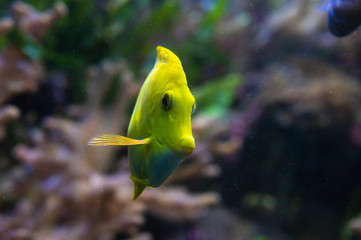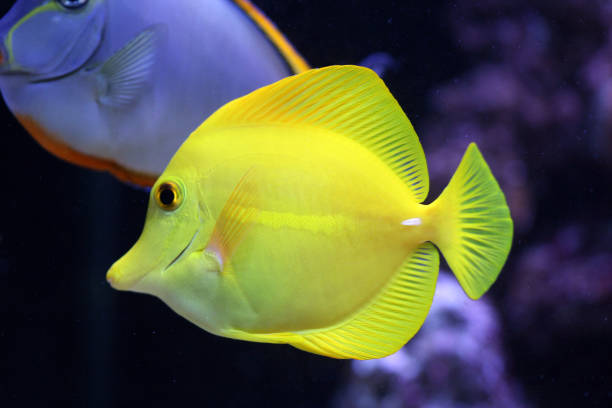Table of Contents
Scientific Classification
| Kingdom | Animalia |
| Phylum | Chordata |
| Class | Actinopterygii |
| Order | Acanthuriformes |
| Family | Acanthuridae |
| Genus | Zebrasoma |
| Species | Zebrasoma flavescens |
| Scientific Name | Zebrasoma flavescens |
Description
The Yellow Tang (Zebrasoma flavescens) is a beautiful fish, famous for its vibrant yellow color. It features a laterally compressed, oval-shaped body that can reach lengths of up to 8 inches (20 cm). Its striking hue makes it a favorite among aquarium enthusiasts and plays an important role in coral reef ecosystems. At the base of its tail, the Yellow Tang has a sharp, white spine, which it uses for self-defense and to establish territory. This fish is very active and is often seen swimming gracefully among coral formations.
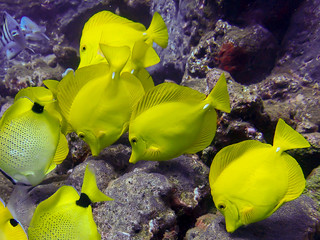
Distribution
Yellow Tangs are primarily found in the Pacific Ocean, particularly around the Hawaiian Islands, Japan, and certain regions of Micronesia. These fish are some of the most well-known reef inhabitants in these waters, with a notable abundance in Hawaiian regions. Conservation initiatives have played a significant role in maintaining their population stability.
Habitat
Yellow Tangs flourish in warm, shallow waters, usually found at depths ranging from 5 to 150 feet (1.5 to 45 meters). They prefer habitats like coral reefs, lagoons, and rocky shorelines. These environments provide both shelter and abundant food sources. Coral reefs serve as a refuge for fish, shielding them from predators and strong currents, making them an ideal home for these vibrant fish.
Diet
Yellow Tangs are primarily herbivores, with a diet that consists mainly of algae. This feeding behavior plays a crucial role in maintaining the health of coral reef ecosystems. They consume algae that grows on rocks and corals, which helps prevent overgrowth that can suffocate coral structures. In captivity, their diet typically includes seaweed, spirulina, and various other plant materials, aiming to replicate their natural feeding habits in the wild.
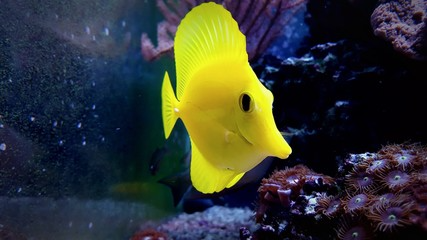
Behavior
Yellow Tangs are active during the day and rest at night, making them diurnal. These fish are social and are often spotted swimming in loose groups or pairs. However, they can also be territorial and may show aggression towards other Tangs or fish that invade their space. Their sharp caudal spines serve as weapons during disputes over territory and food. Despite their occasional aggression, they usually get along well with other reef fish.
Lifespan
Yellow Tangs typically live between 5 to 10 years in the wild, but under ideal conditions, some can even reach 30 years. In captivity, their lifespan varies based on the quality of care, water conditions, and diet. With the right care, they can thrive for 10 to 20 years in home aquariums.
Reproduction and Lifecycle
ellow Tangs reproduce by means of external fertilization. At dusk, during the spawning period, both males and females release their eggs and sperm into the water. The fertilized eggs float freely and typically hatch within 24 hours. The larvae then drift in the open ocean for several weeks before eventually settling onto coral reefs. Juvenile Yellow Tangs are smaller and may appear different from the adults. As they grow, they gradually develop their vibrant yellow color.
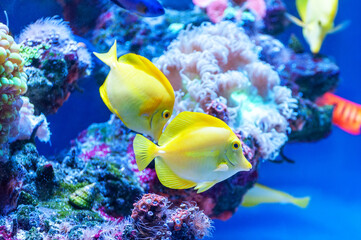
Predators
Yellow Tangs encounter a variety of natural predators. Larger reef fish such as groupers, snappers, and moray eels are among their main threats. Additionally, sharks and certain seabirds may hunt them. While their bright colors can attract predators, their swift movements and sharp tail spines provide a level of protection. To avoid danger, they frequently hide in coral crevices.
Adaptations
Yellow Tangs have developed various adaptations to thrive in their coral reef environments:
Their bright yellow coloration allows them to blend in with the coral and the patterns of sunlight filtering through the water.
Laterally Compressed Body: This design enables them to navigate through narrow spaces in the reef and evade predators.
Sharp Caudal Spine: This feature serves as a defense mechanism against threats from predators and competitors.
Efficient Algae Eating: They feed on algae, which helps maintain the health of the reefs by preventing overgrowth that could damage corals.
Conservation Status
The Yellow Tang is classified as Least Concern on the IUCN Red List, indicating that its population remains stable. However, factors such as habitat loss, climate change, and overcollection for the aquarium trade pose threats to its long-term survival. To protect wild populations, Hawaii has implemented regulations governing the collection of Yellow Tangs for the pet trade.
Conclusion
The Yellow Tang is an intriguing and vital component of coral reef ecosystems. Its vibrant appearance, important function in controlling algae, and active behavior make it a favorite among divers and aquarium enthusiasts.
